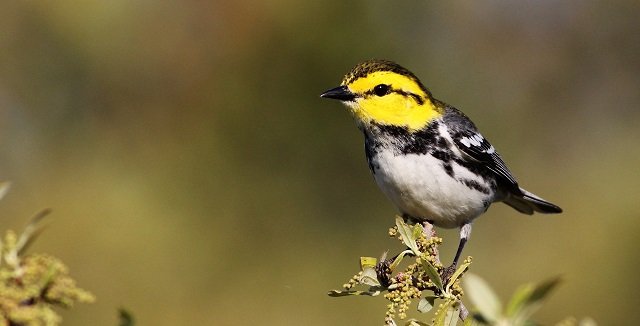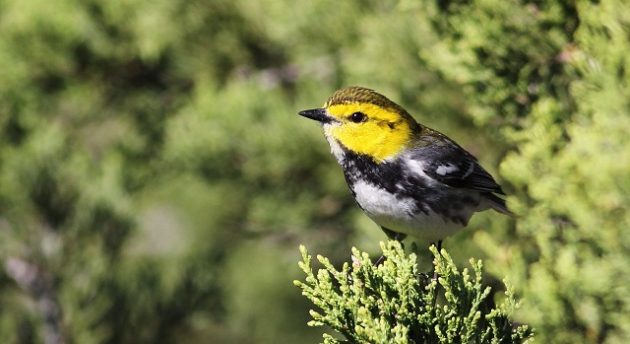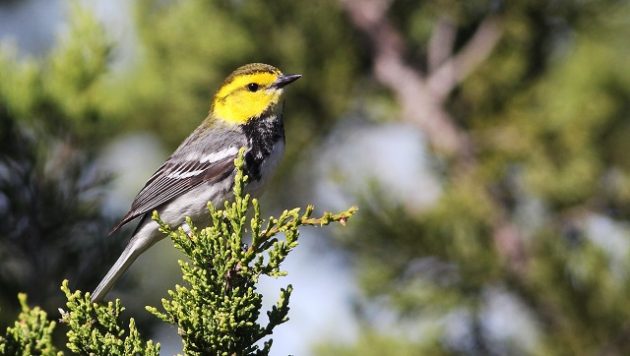
The endangered Golden-cheeked Warbler breeds only in Texas Hill Country near Austin and San Antonio, but much of its nesting grounds have cleared in favor of subdivisions. Given the explosive growth of the region, development will continue, placing additional pressure on the warbler’s vanishing habitat. One way developers are navigating the warbler’s endangered status is by utilizing conservation banks.
What is a conservation bank?
# # #
First, some background regarding the Endangered Species Act (ESA) and the listing of the Golden-cheeked Warbler is required.
In 1990, the U.S. Fish and Wildlife Service (FWS) declared the Golden-cheeked Warbler “endangered.” The primary basis for that determination was the destruction and fragmentation of its habitat, mature stands of Ashe juniper trees. In 2014, FWS completed a five-year status review, concluding that development still threatened the warbler. A recent lawsuit seeking to delist the warbler was unsuccessful. Thus, the Golden-cheeked Warbler remains “endangered,” meaning there are limits on activities that might harm the bird.
One result of the listing of the Golden-cheeked Warbler (and that of the Black-capped Vireo) was the establishment of Balcones Canyonlands National Wildlife Refuge, which protects approximately 25,000 acres near Austin.
Although many ESA regulations apply only to federal agencies, private entities that take actions that could adversely impact a listed species must first obtain a permit. For example, a developer building a subdivision will likely harm warbler habitat even though that is not the goal of the development. That is, the harm is “incidental.” Under Section 10 of ESA, an “incidental take permit” must be obtained and one requirement of that permit is a “habitat conservation plan” (HCP).
An HCP can have many elements, such as reducing the impact on a listed species (e.g., not clearing trees during nesting season) and one common element is “mitigating” for habitat loss. For example, a developer could set aside land for protection within the project (“on-site mitigation”). Or it might opt to offset habitat losses by purchasing and protecting habitat elsewhere (“off-site mitigation”). That would theoretically result in “no net loss” of habitat.
In some areas, conservation banks have been created to facilitate “off-site mitigation.” These banks are touted as market-based solutions with advantages for both developers and imperiled species. For example, rather than numerous small piecemeal mitigation efforts spread across many parcels, a conservation bank can preserve large contiguous parcels and specifically manage them for an endangered species. Moreover, larger sites are better for wildlife and are easier and less expensive to manage. For developers, a one-time transaction permanently satisfies its obligations and provides regulatory certainty.
How does it work?
Every conservation bank must be approved by FWS. That requires: (1) entering into an agreement with FWS, (2) obtaining land and granting a conservation easement that precludes future development of that land, (3) creating a management plan, and (4) arranging for funding to permanently monitor and manage the property. Funding typically consists of an interest-bearing account that generates enough income to manage the property. Only interest is used to fund management and the principal is not touched, creating a “non-wasting endowment,” i.e., a permanent funding source.
If the criteria are satisfied, FWS approves the bank to sell a specified number of credits to developers or others seeking mitigation services. The credits are good only within an area relatively close to the project, called the bank’s “designated service area.” Thus, off-site mitigation occurs near impacted land.
A conservation bank uses “credits,” which may be bought, sold, or traded to those in the mitigation marketplace. Credit values are based on biological criteria such as habitat quality, habitat quantity, species covered, and other conservation benefits. For example, a bank could acquire 10,000 high-quality acres that, once assessed by FWS for biological value, allow the bank to sell 10,000 “credits.”

In 2013, FWS issued a document entitled “Guidelines for the Establishment, Management, and Operations of Golden-cheeked Warbler and Black-capped Vireo Mitigation Lands.” There are now several conservation banks that offer credits for Golden-cheeked Warbler mitigation.
For example, the Bandera Corridor Conservation Bank (BCCB) provides mitigation offsets in several counties in Texas Hill Country. The bank states that it is a “partnership between private landowners and conservation-minded investors” and that it has initially focused on the area near two protected areas, The Nature Conservancy’s Love Creek Preserve and Lost Maples State Natural Area. The bank has “a goal of enrolling 10,000 acres of suitable habitat.” To date, it has provided more than 2,650 “GCW Preservation Credits.”
The list of companies and other entities that have used BCCB suggest a mix of quarries (e.g., CEMEX Balcones Quarry), public utilities (e.g., Lower Colorado River Authority Transmission Services Company), and the military (e.g., Camp Bullis).
How much does it cost? There is at least one data point: The Davis-McCrary Property Trust owns a 724-acre property in Bexar County known as the Davis Ranch and its HCP describes measures to mitigate impacts on the warbler. Among them is use of a conservation bank: “the Permittee anticipates that the total cost to purchase 1,176.73 conservation credits will be between $5,295,285 and $5,883,650, based on a current quoted market price of between $4,500 and $5,000 per conservation credit.”
# # #
Whatever the long-term effectiveness of these conservation banks (there have been no long-term evaluations), they are shaping conservation of the Golden-cheeked Warbler in the hills of central Texas.

Golden-cheeked Warbler photos (1, 2, 3) by Cameron Rutt.













I recently visited the Balcones area to try to see a Golden Cheeked Warbler (success!) and you’d better believe that the gated communities are there and proliferating. Hope this program results in enough land for a stable population of these unique warblers.